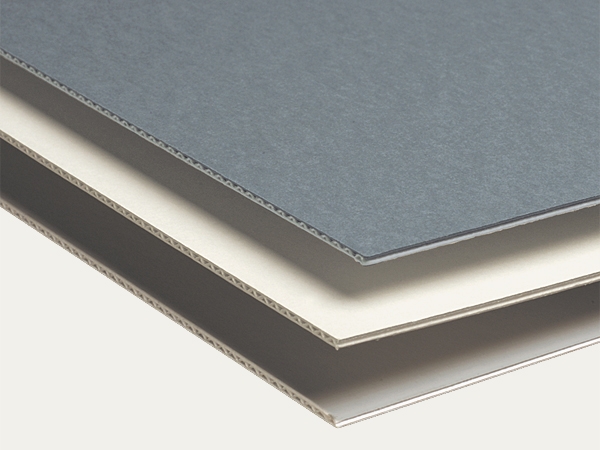KLUG Corrugated Board qualities have been upgraded
In 1990 KLUG -CONSERVATION started as the first company in Europe to offer products made from permanent corrugated board material in accordance with the ISO 9706 standard.
In those days the material was shipped container-wise from the US to Europe. The standard of quality was based on the requirements set by the "Library of Congress" in Washington. The material constituency of the upper plies and the corrugated material was based on short-fibered papers. The tensile strengths were still very low and the product assortment limited.
In 1993 we manufactured the first permanent corrugated board qualities to our set regulations. The craft pulp cellulose boards were produced in accordance with very strict terms set by ourselves. The top and lower plies were printed in light grey. Since September 2004, particularly in response to the heavy flooding that took place in Eastern Germany, the individual plies of the corrugated board were glued together moisture-proof by means of a special treatment, to ensure water-resistance. This unique method guarantees, in the case of water damage, durability (water-resistance) of a minimum of 24 hours. Parallel, the ISO 9706 standard as well as the dutch ICN 11 norm were also accomplished.
In May 2005, within the framework of the project "Pollution in Museums" undertaken by the Frauenhofer Wilhelm-Klauditz Institute in Braunschweig/Germany, KLUG's corrugated boards were examined in relation to their self-generated pollution emissions. After several weeks of storage, self-generated emissions could not be verified as the measured emission data was within the blank value. In March 2006 we made our first attempt to laminate corrugated board with a 300 gsm, grey-blue archival board ply. The puncturing resistance was increased significantly, due to the direct application of the 0.35 mm thick archival board ply. This was achieved by means of lamination onto the ply. The upper ply, with its smooth and erasable surface texture had excellent grooving and folding characteristics. This hybrid between a complete solid board and a corrugated board quality has proven itself over the years especially due to the outstanding cost-savings ratio.
In 2009 we significantly succeeded in improving the colour fastness and water proofness of the printed upper ply of KLUG corrugated boards.
Colourfastness - Lightfastness
The lightfastness of a dye describes the colour consistency by prolonged exposure to light, in particular with ultra violet rays. Depending upon the dye composition this property can vary immensely. The lightfastness of a coloured material indicates the extent of colour change that occurs and is expressed by a factor between 1 (bad) and 8 (very good) in accordance with the wool scale or in accordance with the blue scale DIN 53952. Normal paper and board qualities have a lightfastness ranging between 2 and 4. Premium quality mat and mount boards have the value 6. Due to changes made in the colour composition of the dye, KLUG-CONSERVATION has succeeded in increasing the wool scale value of the upper ply of their corrugated board to 7. This also leads to that fact that the colourfastness of archival storage boxes after prolonged exposure to light were not effected, hence did not change their colour.
Waterproofness of the board colour and top surface
Since 2004 the individual plies of the corrugated board have been glued together by using a special moisture-proof treatment, hence the immense increase in water-resistance. Infact the colourfastness of the dye also showed no decolouration after 50 hours of exposure to moisture and water. This also resulted in the prevention colour bleeding of the top ply. Both the achieved lightfastness and waterfastness exceed the current highest standards set by the Library of Congress in Washington for archival storage purposes. The water damages which have taken place in the recent past in archives and store rooms, have in particular shown that these properties of waterproofness of the top surface ply, the colour and glueing of the individual plies of the corrugated board were not secure enough to prevent damaging the inventories.

